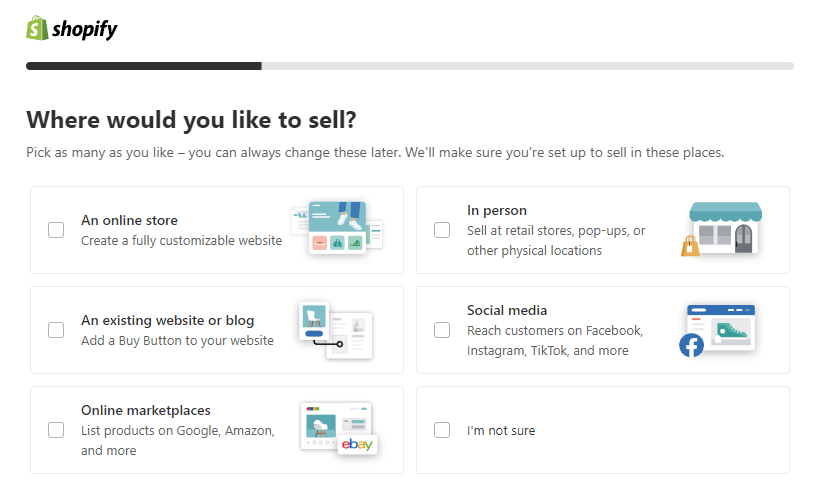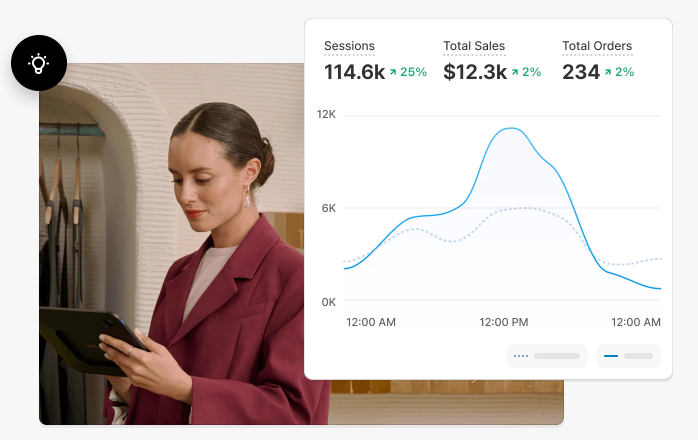How To Start Using Shopify To Launch Your E-Commerce Store

In the age of online shopping, e-commerce plays a crucial role. Technology and the internet have completely changed how businesses operate and what consumers expect from the companies they buy from.
The ease and accessibility it offers have transformed the modern business landscape, allowing both startups and established companies to reach global audiences, build their brands, and drive sales more effectively. Understanding how to leverage e-commerce platforms has become essential for any business aiming to succeed in today’s competitive market.
When it comes to setting up and managing an online store, Shopify stands out among the rest. With its intuitive interface, customizable settings, and comprehensive set of tools and services, Shopify has redefined how businesses establish their presence on the web.
From small ventures to large enterprises, Shopify has proven to be a reliable option, helping users create, manage, and grow their operations. With its strong infrastructure and wide range of features suited for different needs, Shopify remains the top choice for countless online businesses around the world.
In the guide that follows, we’ll show you how to leverage Shopify to take your online business to new heights.
Getting Started with Shopify
Signing up for a Shopify account
To get started with Shopify, the first step is to sign up for an account. This process is straightforward and can be initiated by visiting the Shopify website. You’ll need to provide basic information, such as your email address, password, and store name, to create your account.
Additionally, you’ll be prompted to answer a few initial questions to help Shopify understand your business requirements better.
Navigating the Shopify dashboard
Once you’ve successfully created your account, you’ll gain access to the Shopify dashboard, which serves as the central hub for managing your e-commerce store. The dashboard offers a user-friendly interface, allowing you to navigate various sections such as orders, products, customer lists, analytics, and more. Familiarizing yourself with the layout and functionalities of the dashboard is important for effectively managing your store’s operations and monitoring its performance.

Customizing your store's settings and theme
One of the most appealing aspects of Shopify is its versatility and ability to customize to fit the look and feel of your company. You can tailor your store’s settings to align with your brand identity and specific business requirements.
From configuring payment and shipping options to defining tax settings and customer accounts, Shopify provides a comprehensive array of tools to streamline the setup process.
Most importantly, you have the ability to select an appropriate theme that reflects your brand’s aesthetics and values. Shopify offers a wide range of free themes that are native to the platform, enabling you to create an appealing and user-friendly storefront that resonates with your target audience. There are also paid, premium options that are fully customizable.
Through the intuitive theme editor, you can effortlessly modify the layout, colors, fonts, and other visual elements to establish a captivating online presence that leaves a lasting impression on your potential customers.

Adding Products to Your Store
Creating product listings
The process of adding products to your Shopify store involves creating detailed and engaging product listings that effectively showcase your merchandise. When adding a new product, you’ll be prompted to input essential details such as the product title, description, price, and inventory information.
You can also specify product variants, including size, color, and other options, to cater to diverse customer preferences. Utilizing Shopify’s product listing interface, you can efficiently manage your inventory and keep track of stock levels to ensure end-to-end order fulfillment.

Optimizing product descriptions and images
Crafting compelling product descriptions and utilizing high-quality images are pivotal for attracting and retaining customer interest. By incorporating persuasive and informative descriptions that highlight the unique selling points of your products, you can effectively communicate their value to potential buyers.
Additionally, optimizing product images by using high-resolution photos from multiple angles and incorporating zoom features can significantly increase the visual appeal of your store. This attention to detail can instill trust and confidence in your customers, leading to increased conversions and greater customer loyalty.
Organizing products into collections
Organizing your products into collections can streamline the shopping experience for your customers and facilitate easy navigation within your store. With Shopify’s collection feature, you can categorize products based on specific criteria such as product type, season, or special promotions.
By creating well-structured collections and implementing navigation menus that feel natural, you can help customers discover relevant products more efficiently, encouraging them to explore and make additional purchases. Effective product organization elevates the overall user experience and contributes to a more cohesive and engaging shopping environment for your audience.
Managing Orders and Payments
Setting up payment gateways
Integrating secure and efficient payment gateways is needed to facilitate transactions and ensure a smooth checkout process for your customers. Shopify offers a wide range of payment gateway options, including popular providers such as PayPal, Stripe, and Shopify Payments, among others.
Setting up these payment gateways involves configuring the necessary account details within the Shopify platform to enable swift and secure payment processing. By offering multiple payment options instead of just one, you can cater to a broader customer base and improve the experience for your clientele.
After all, no one likes being boxed in and forced to pay a certain way. Everyone has their own preferences, and it’s important to take those into account so you never miss out on a sale.
Understanding order management features
Effectively managing incoming orders is vital for maintaining operational efficiency and delivering exceptional customer service. Shopify’s order management features enable you to track orders, manage inventory, and process shipments seamlessly.
You can monitor order statuses, generate invoices, and provide customers with real-time updates on their purchase and shipment progress. Making the most of these features empowers you to streamline your order fulfillment process, reducing the likelihood of errors and guaranteeing timely delivery of products to your customers.

Handling customer transactions securely
Ensuring the security of customer transactions is paramount in building trust and fostering long-term relationships with your shoppers. Shopify employs strong security protocols to safeguard sensitive customer information and financial data.
Implementing SSL encryption and adhering to industry-standard security practices are essential for protecting customer privacy and preventing fraudulent activities. By prioritizing data security and complying with regulatory requirements, you can give your customers the confidence they need to shop without reservations, reassuring them that their transactions are conducted in a safe and secure environment.
Enhancing Your Store with Apps and Plugins
Exploring the Shopify App Store
The Shopify App Store serves as a treasure trove of diverse applications designed to enhance the functionality and performance of your e-commerce store. By exploring the extensive collection of apps, you can discover a wide range of tools and resources tailored to meet specific business needs, including marketing, sales, customer support, and inventory management, among others.
These apps are developed by third-party providers and offer customizable solutions to help you optimize and expand the capabilities of your Shopify store.

Installing and integrating essential apps for your store
After identifying the key areas where your store can benefit from additional functionalities, installing and integrating essential apps becomes instrumental in enhancing your store’s performance.
Whether you’re looking to streamline your marketing efforts, improve customer engagement, or simplify your logistics, selecting and integrating the right apps can significantly boost your operational efficiency and drive business growth.
Carefully evaluate each app’s features, user reviews, and compatibility with your business requirements before integrating them into your Shopify store.
Implementing Effective Marketing Strategies
Utilizing SEO techniques to improve visibility
Search Engine Optimization (SEO) plays a pivotal role in enhancing your store's online visibility and driving organic traffic. By optimizing product descriptions, titles, meta tags, and URLs with relevant keywords, you can improve your store's search engine ranking and increase the likelihood of being discovered by potential customers.
Creating valuable and engaging content, such as blog posts and product guides, further strengthens your SEO efforts and establishes your store as an authoritative and reliable source within your niche. By staying informed of the latest SEO trends and best practices, you can effectively position your store for sustained growth and increased visibility in the competitive
e-commerce landscape.
Leveraging social media and email marketing
Harnessing the power of social media and email marketing is essential for fostering customer engagement and building lasting relationships with your audience. By strategically utilizing platforms such as Instagram, Facebook, X (formerly Twitter), and LinkedIn, you can promote your products, share compelling content, and interact with your customers in a more personalized and authentic manner.
Implementing targeted email marketing campaigns with tools like Klaviyo to offer exclusive promotions, and personalized recommendations can further nurture customer loyalty and drive repeat purchases. Consistent and thoughtful engagement across social media and email channels can significantly amplify your brand's reach and strengthen your overall marketing efforts.
Running promotional campaigns and discounts
Running periodic promotional campaigns and offering meaningful discounts can incentivize customer acquisition and encourage repeat purchases. Creating limited-time offers, seasonal sales (think Black Friday and Cyber Monday), and loyalty programs can entice customers to explore your products and make timely purchases.
Leveraging Shopify's built-in promotional tools, such as discount codes and gift cards, can streamline the process of creating and managing promotional campaigns, allowing you to effectively track their impact on sales and customer engagement.
By strategically aligning your promotional activities with key shopping seasons and events, you can capitalize on consumer spending trends and drive heightened interest in your products, thereby boosting your store's overall sales and revenue.

Analyzing Performance and Optimizing Your Store
Tracking and analyzing key e-commerce metrics
Monitoring and analyzing key e-commerce metrics is essential for gaining valuable insights into the performance of your online store. By tracking metrics such as website traffic, conversion rates, average order value, and customer acquisition costs, you can assess the effectiveness of your marketing strategies and identify areas for improvement. Additionally, analyzing customer behavior, including browsing patterns and purchasing trends, can provide valuable data for optimizing your product offerings.

Using Shopify's analytics tools
Shopify offers a comprehensive set of built-in analytics tools that enable you to assess the performance of your store. From the Shopify dashboard, you can access detailed reports and metrics, including sales reports, customer reports, and marketing reports, among others.
These analytics tools provide valuable insights into customer preferences, product performance, and overall sales trends, allowing you to make informed decisions to drive your business forward. Leveraging these tools effectively empowers you to gain a deeper understanding of how your brand is reaching people in the real world.
Making data-driven decisions to improve sales and conversions
By analyzing the data collected from Shopify’s analytics tools and other integrated platforms, you can identify customer trends, preferences, and pain points, enabling you to tailor your marketing strategies and product offerings accordingly.
Implementing A/B testing for various elements such as product layouts, pricing strategies, and promotional campaigns can further validate your decisions and help you identify the most effective approaches. By embracing a data-driven approach, you can continuously refine and optimize your store, ensuring you are able to cut through the noise and achieve long-term sustainable growth.
Ensuring a Smooth Customer Experience
Implementing user-friendly navigation and interface design
Creating a user-friendly and intuitive navigation system enhances the overall customer experience on your Shopify store. By organizing products into easily accessible categories and implementing clear navigation menus, you can help customers explore your product offerings and find what they're looking for without frustration.
re your products and make timely purchases.
Intuitive interface design, including clear call-to-action buttons and responsive layouts, further contributes to a pleasant shopping experience, encouraging visitors to engage with your store and make informed purchase decisions.
As a large percentage of customers shop on their phones, always make sure that your storefront is optimized for mobile browsing.
Offering reliable customer support and assistance
Implementing various support channels, such as live chat, email, and phone support, enables customers to seek assistance whenever they encounter issues or have inquiries about products or services. Timely and personalized responses to customer queries or concerns demonstrate your commitment to customer satisfaction and can significantly influence customer loyalty and retention.
By prioritizing exceptional customer support, you can cultivate a positive brand reputation and distinguish your store as a customer-centric e-commerce destination.
Optimizing the checkout process for seamless transactions
Streamlining the checkout process is essential for minimizing cart abandonment and ensuring a hassle-free transaction experience for your customers. By implementing a simplified and
user-friendly checkout interface, you can reduce the number of steps required to complete a purchase and offer multiple secure payment options to accommodate a variety of customer preferences.
Additionally, incorporating guest checkout functionality and providing clear shipping and return policy information during the checkout process can encourage your customers to finalize their purchases. Optimizing the checkout process for speed, convenience, and security is crucial for maximizing conversions and delivering a seamless customer experience from start to finish.
Scaling Your Business with Shopify
Exploring advanced Shopify features for growth
As your business continues to expand, leveraging advanced features offered by Shopify can facilitate further growth and development. Features such as Shopify Plus, which is tailored for high-growth businesses, provide access to advanced functionalities like automation, personalized checkouts, and custom script integrations.
By exploring and utilizing these advanced features, you can improve your store’s performance, streamline operations, and cater to a larger customer base while maintaining a superior level of service and efficiency.
Considering expansion strategies and market opportunities
When scaling your business with Shopify, it’s essential to consider strategic expansion opportunities and hot trends. Assessing new market segments, exploring international sales opportunities, and diversifying your product offerings can help you tap into new customer demographics and expand your business reach.
Conducting thorough research, identifying emerging consumer needs, and staying on the cutting edge of industry trends can help you formulate effective strategies that align with your business objectives and target market demands.
Scaling operations efficiently while maintaining quality standards
Automating repetitive tasks, optimizing inventory management, and implementing streamlined logistics and fulfillment processes can support increased order volumes. Investing in employee training, implementing quality control measures, and prioritizing customer feedback and reviews are essential for maintaining high-quality standards.
By amping up operational efficiency and maintaining stringent quality standards, you can effectively scale your business while preserving your brand’s integrity and reputation.

Conclusion
Starting your e-commerce journey with Shopify involves several steps, including setting up your account, customizing your store, adding products, managing orders, and implementing effective marketing strategies. It’s essential to familiarize yourself with Shopify’s features and tools to optimize your store’s performance and give your customers something to remember.
A well-executed Shopify strategy can unlock a world of opportunities for your e-commerce business. By leveraging Shopify’s suite of tools and resources, you can establish a strong online presence, attract a broader audience, and drive sales growth.
With a customer-focused approach and a commitment to delivering exceptional products and services, your Shopify-powered store has the potential to thrive in the competitive e-commerce landscape.
Continuously learning and adapting your strategies to meet evolving customer demands and market trends can help you remain agile and responsive to changing consumer preferences. Embracing innovation and exploring new opportunities for growth and development can position your Shopify store for long-term success and sustainability.
Signing up with Shopify is not just about launching an online store – it’s about building a thriving brand that resonates with your target audience and fosters meaningful connections. By implementing the insights and strategies outlined in this guide, you can set a solid foundation for your Shopify store and pave the way for a profitable and rewarding future.


